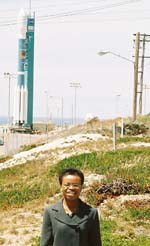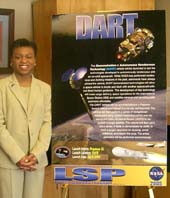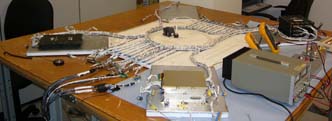Meet the IBEX Team: Wanda Harding

"Three, two, one...liftoff!"
Wanda Harding knows exactly what goes into getting rockets off the ground and into space.
As a NASA Mission Integration Manager, Wanda is part of the team that oversees the Pegasus rocket that NASA will use to launch the IBEX mission into space.
"My primary responsibility for the IBEX mission is to manage the mission integration effort. The integration effort is like a bridge for getting the spacecraft from Earth to space." Wanda said. "The launch vehicles, or rockets, that NASA uses for the spacecraft missions, like IBEX, are provided as commercial launch services."
NASA contracts private corporations like Orbital Sciences, Boeing, and Lockheed Martin to provide the launch services. "Believe it or not, the only major space launch vehicle fleet that NASA, as an agency, currently owns is the Space Shuttle," Wanda said.
Wanda oversees the team of people who make sure that the rocket for the IBEX mission does everything it needs to do to get the spacecraft into space. "By the time we get ready to launch, we want to be sure and confident the rocket is going to put the IBEX flight system exactly where it needs to be. We will be able to do that because we follow the design and development of the vehicle, and subsequently verify the modifications necessary to meet the unique spacecraft requirements," Wanda said.

Her team includes engineers, contract and budget experts, launch site managers, and others who understand the unique launch vehicle and spacecraft requirements. They must make sure that the launch services can carry out special functions that are exclusive to the IBEX spacecraft. "One of the unique and challenging requirements for the IBEX mission is that it is one of the heaviest payloads we've placed on the Pegasus launch vehicle.
We also have a requirement to spin the flight system up to about 60 rotations per minute prior to spacecraft separation. That's fast for a 'spacecraft sep' event!" she said.
The team will address these and other unique requirements at the upcoming Mission Unique Design Review (MUPDR). "This design review will help us determine whether or not we are heading in the right direction to meet the requirements for IBEX," Wanda said.
Wanda has really enjoyed her career with NASA. "It's neat to be able to do something that's out of the ordinary. I also think it's great that NASA offers so many different opportunities within the Agency, both here and abroad."
Wanda lists two best parts of her job. "The best part of my job is twofold - one is being able to work on a project that has a definite start and end, which for us is a successful launch. The other is being able to work with the spacecraft teams, because NASA does some pretty interesting stuff!"
In addition to the IBEX mission, the other "interesting stuff" Wanda works on includes the Lunar Reconnaissance Orbiter (LRO) and the Lunar Crater Observation and Sensing Satellite (LCROSS). "LRO and LCROSS are the first of a series of missions in NASA's Robotic Lunar Exploration Program. LCROSS is actually going to impact the lunar surface in search of water ice," she said. All three spacecraft are currently scheduled to launch in 2008.
Wanda did not always plan a career in space science. As a child in Atlanta, Georgia, Wanda often dreamed about becoming a concert pianist. It wasn't until she enrolled in a science-focused high school that she discovered her interest in engineering. ""I was motivated by the challenge. It was something different, so I decided to try it out," she said. She still finds time for music by playing piano for the children's choir at her church.
After high school, Wanda earned a bachelor's degree from Hampton University and master's degree from Georgia Institute of Technology, both in electrical engineering. She credits her parents with inspiring her to pursue her dreams. "My parents were both educators and excellent role models. They were also people that met challenges, and by doing so, have set a good example, not only for me, but for others as well," she said.
For young people who would like to follow in her footsteps, Wanda offers two pieces of advice: major in a math or science-related field and do your best to become a well-rounded person. "Because you will interact and interface with all types of people, it is certainly to your advantage to have exposure to other fields beyond your immediate major," she said.
Wanda hopes to inspire the next generation of space explorers. "The next chapter of my life may even include someday becoming a high school physics or math teacher," she said.
